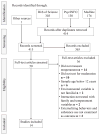The interaction between temperament and the family environment in adolescent substance use and externalizing behaviors: Support for diathesis-stress or differential susceptibility?
- PMID: 27413247
- PMCID: PMC4939280
- DOI: 10.1016/j.dr.2016.03.003
The interaction between temperament and the family environment in adolescent substance use and externalizing behaviors: Support for diathesis-stress or differential susceptibility?
Abstract
Both individual and environmental factors predict externalizing behaviors and substance use (EB-SU); however, different patterns of interaction among these factors may have different implications. This review first examines how temperament and the family environment interact in the prediction of adolescent EB-SU. Second, studies are reviewed according to two theoretical models: (1) diathesis-stress, i.e., certain individual characteristics are linked to vulnerability and later problems in adverse environments; (2) differential susceptibility, i.e., these characteristics are linked to susceptibility, predicting problems in adverse environments, but also better than average outcomes in good environments. Fourteen studies focusing on the prediction of EB-SU at ages 12-18 were selected through a literature search. Results showed that certain temperament traits (high levels of impulsivity and disinhibition; low levels of effortful control, negative affect, fearfulness and shyness), hereby designated as "adventurous" disposition, were associated with higher levels of EB-SU in adverse family environments. Some studies also showed that children with "adventurous" temperament traits in positive environments had the lowest levels of EB-SU. This suggests that prevention of EB-SU might target family factors such as parenting and focus on children with "adventurous" temperament traits. Further, studies that supported the differential susceptibility model were those assessing temperament and the family environment in childhood and studies that supported the diathesis-stress model assessed these variables in adolescence. It is thus possible that some of these "adventurous" temperament traits, with regard to EB-SU, would be indicators of susceptibility to both enriched and adverse environments in childhood but no longer in adolescence, when they would only be indicators of vulnerability to adverse environments.
Keywords: Diathesis–stress; Differential susceptibility; Externalizing; Family; Moderation; Temperament.
Figures
Similar articles
-
Temperamental sensitivity to early maltreatment and later family cohesion for externalizing behaviors in youth adopted from foster care.Child Abuse Negl. 2018 Feb;76:149-159. doi: 10.1016/j.chiabu.2017.10.018. Epub 2017 Nov 3. Child Abuse Negl. 2018. PMID: 29102869
-
Differences in sensitivity to parenting depending on child temperament: A meta-analysis.Psychol Bull. 2016 Oct;142(10):1068-110. doi: 10.1037/bul0000061. Epub 2016 Aug 11. Psychol Bull. 2016. PMID: 27513919
-
Patterns of Sensitivity to Parenting and Peer Environments: Early Temperament and Adolescent Externalizing Behavior.J Res Adolesc. 2019 Mar;29(1):225-239. doi: 10.1111/jora.12382. Epub 2018 Mar 14. J Res Adolesc. 2019. PMID: 29537722 Free PMC article. Review.
-
Childhood temperament and family environment as predictors of internalizing and externalizing trajectories from ages 5 to 17.J Abnorm Child Psychol. 2005 Oct;33(5):505-20. doi: 10.1007/s10802-005-6734-7. J Abnorm Child Psychol. 2005. PMID: 16195947 Free PMC article.
-
From temperament and parenting to attachment: a review of the interplay of gene and environment factors in the developmental pathway to attachment.Curr Opin Psychiatry. 2022 Nov 1;35(6):401-408. doi: 10.1097/YCO.0000000000000817. Epub 2022 Aug 10. Curr Opin Psychiatry. 2022. PMID: 35959551 Review.
Cited by
-
Early-childhood temperament moderates the prospective associations of coping with adolescent internalizing and externalizing symptoms.Front Psychol. 2022 Nov 10;13:1011095. doi: 10.3389/fpsyg.2022.1011095. eCollection 2022. Front Psychol. 2022. PMID: 36438327 Free PMC article.
-
Phenotypic Environmental Sensitivity and Mental Health During Pregnancy and Post Partum: Protocol for the Experiences of Pregnancy Longitudinal Cohort Study.JMIR Res Protoc. 2023 Dec 6;12:e49243. doi: 10.2196/49243. JMIR Res Protoc. 2023. PMID: 38055312 Free PMC article.
-
Longitudinal Study of Early Adversity and Disturbing Dream Frequency: Moderating Role of Early Negative Emotionality.Res Child Adolesc Psychopathol. 2024 Feb;52(2):277-291. doi: 10.1007/s10802-023-01109-1. Epub 2023 Aug 17. Res Child Adolesc Psychopathol. 2024. PMID: 37589805
-
Interactions between infant characteristics and parenting factors rarely replicate across cohorts and developmental domains.J Child Psychol Psychiatry. 2025 Aug;66(8):1234-1248. doi: 10.1111/jcpp.14149. Epub 2025 Mar 10. J Child Psychol Psychiatry. 2025. PMID: 40064329 Free PMC article.
-
Parent-reported childhood temperament and adolescent self-reported substance use initiation.Addict Behav. 2020 Nov;110:106503. doi: 10.1016/j.addbeh.2020.106503. Epub 2020 Jun 10. Addict Behav. 2020. PMID: 32622028 Free PMC article.
References
-
- Achenbach TM. Manual for the youth self-report and 1991 profile. Burlington, VT: University of Vermont, Department of Psychiatry; 1991.
-
- Achenbach TM, Edelbrock CS. Manual for the child behavior checklist and revised child behavior profile. Burlington, VT: University of Vermont, Department of Psychiatry; 1983.
-
- Aguinis H. Statistical power with moderated multiple regression in management research. Journal of Management. 1995;21(6):1141–1158.
-
- Aguinis H, Beaty JC, Boik RJ, Pierce CA. Effect size and power in assessing moderating effects of categorical variables using multiple regression: A 30-year review. The Journal of Applied Psychology. 2005;90(1):94–107. - PubMed
Grants and funding
LinkOut - more resources
Full Text Sources
Other Literature Sources


